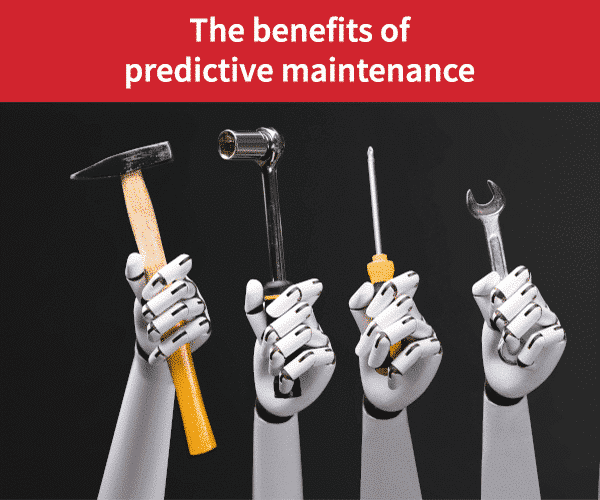
- Field Service Management
- Internet of Things
- Artificial Intelligence
- Work orders
- Technology
Benefits of Preventive Maintenance Systems
A growing number of companies have realized that switching to predictive maintenance helps them reduce operating costs and extend equipment lifespan. As a result, there are compelling examples of the benefits of preventive maintenance in industries ranging from aeronautics and automobiles to railways and energy.
As the old saying goes, prevention is better than cure. Predictive maintenance is all about prevention. With the ability to track equipment operation over time and anticipate breakdowns before they occur, predictive maintenance is like a dream for service professionals.
Predictive maintenance replaces existing maintenance models that are increasingly showing their limitations. For example, with corrective maintenance, the failure has already occurred before anyone steps in to fix it. With preventive maintenance, the maintenance periods are predetermined according to statistics for wear rates, but parts may end up being replaced when they still have considerable life left in them. This underscores why preventive maintenance is important: it optimizes the use of equipment and minimizes waste.
The saying “prevention is better than cure” is relevant to maintenance activities. In today’s era of big data, Industry 4.0, and the Internet of Things (IoT), new technologies enable field service companies to evolve from corrective maintenance to predictive strategies. The point of preventive maintenance is to proactively manage systems and components, thereby preventing issues before they become critical and costly. A June 2017 study by the Aberdeen Group Research Institute shows that 37% of service companies plan to use predictive analytics tools to enhance their maintenance strategies. In this complete guide to preventive and predictive maintenance, we will introduce you to preventive and predictive maintenance and tell you a bit about the benefits it can bring to your business.
Corrective, preventive and predictive maintenance
Let’s start with a few definitions. What is corrective maintenance? Corrective maintenance, also called curative maintenance, ensures that equipment is repaired after a failure has occurred. Failures are not predicted or anticipated.
Instead, technicians intervene to correct the problem after the breakdown. So, what is preventive maintenance? Preventive maintenance ensures that equipment receives regularly scheduled service to help keep it running smoothly. Because maintenance activities are scheduled based on the expected lifecycle of equipment, preventive maintenance can help anticipate and avoid potential failures.
The timing of problem detection is the main drawback of preventive maintenance. If wear or a defect is detected on a part in fully functioning equipment, that part is replaced as a precaution in case it could lead to a failure down the road. This approach often results in unexpected expenses that customers could have avoided or postponed.
What is predictive maintenance? Predictive maintenance helps determine the condition of in-service equipment and predicts when maintenance should be performed. This approach promises cost savings over routine or time-based preventive maintenance because tasks are performed only when warranted,” according to the Wikipedia predictive maintenance definition.
It’s important to define predictive maintenance clearly to understand its full benefits. Predictive maintenance pushes maintenance tasks a step further than preventive maintenance. To predict when maintenance is required, intelligent sensors are added to equipment so they can transmit data about equipment operation. By analyzing the data sent by the sensors, field service companies can adopt a “just in time” approach, repairing or replacing equipment just before a failure occurs to optimize the amount of time equipment can be used. This is a cornerstone of predictive maintenance services.
Predictive maintenance forecasts technical issues instead of allowing them to occur. With predictive maintenance best practices, field service companies can schedule service calls in advance to avoid unexpected stoppages in equipment operation.
Setting up a predictive maintenance strategy
The first step in establishing a predictive maintenance strategy is to install sensors on the equipment. The sensors allow you to collect data about the equipment’s operational state. You can then use predictive maintenance software to analyze the data according to specific parameters. This lets you establish what normal behavior looks like and set the thresholds at which imminent failure warnings are generated.
Smart sensors
Several different types of industrial sensors are available. Many types of modern equipment come with smart sensors already installed. Here are just a few of the many types of sensors used today, which are integral predictive maintenance tools:
- Ultrasonic flaw detection
- Infrared thermographic analysis
- Vibration analysis
- Fluid analysis
- Oil analysis
- Spectral analysis
Artificial intelligence and predictions
Analytics tools help you reveal the insight hidden in the data collected by sensors, so you know where maintenance is required. This is the world of artificial intelligence (AI), specifically predictive maintenance AI. AI algorithms can find and analyze the data characteristic of an imminent breakdown. From there, the algorithms model similar data combinations and failure scenarios and set warning thresholds accordingly.
When one of the combinations reappears, a failure is considered to be imminent. When field service management software, such as the solution offered by Praxedo, is connected to analytics software, you can automate decisions about which maintenance activities must be scheduled and in what timeframe.
Integration of information systems
Integrating all of the different information systems involved with a predictive maintenance system is critical to the success of a predictive maintenance strategy. Maintenance data must be centralized so it can be accessed by the analytics software. Cloud technologies enable this data centralization, providing predictive maintenance solutions. The Aberdeen Group study indicates that companies using predictive analytics technologies to enable maintenance strategies are 33% more efficient in creating a unified view of their data from all of their information systems.
Predictive maintenance costs and benefits
Why is preventive maintenance important? Implementing a predictive maintenance strategy provides significant savings over corrective and preventive maintenance because tasks are only performed at the appropriate time. You can anticipate when a failure will occur and intervene only when the need is established.
Timing, cost, and operational tradeoffs are balanced: costs are reduced because service is not provided before it is needed, and complete breakdowns are avoided because service is provided just in time. This approach leads to substantial predictive maintenance cost savings.
Initial investments are needed…
There are advantages of preventive maintenance, but how to implement predictive maintenance? Implementing a predictive maintenance strategy can be a significant cost to your business. You’ll need the sensors necessary to ensure continuous equipment monitoring and analytics software to extract insight from the sensor data.
You must also consider the cost of training your teams to take full advantage of these new data analysis tools. Then, you must plan the time to develop and deploy the program…
To enable significant operational benefits
In return for the time and money you put into your predictive maintenance program, there are enormous benefits of predictive maintenance, especially over the long term:
- A significant reduction in equipment breakdowns and downtime
- Better equipment monitoring so you can anticipate minor incidents that could lead to larger problems
- Optimal use of equipment (until the moment before failure) and a longer life expectancy
- Higher equipment reliability to optimize production
- Better ability to plan maintenance activities and prepare maintenance teams for the required tasks
- Better spare parts management
- Lower maintenance and downtime costs for equipment
As an example, in 2014, the consulting firm Roland Berger produced a study indicating that energy companies that implemented predictive maintenance programs successfully eliminated up to 75% of equipment failures. This proof point perfectly captures the concrete predictive maintenance advantages and why preventive maintenance is important, particularly in the industrial sector, where maintenance-related interruptions in production facilities can quickly become very expensive.
Moreover, understanding the benefits of preventive maintenance can help businesses realize why investing in these strategies is crucial. So, when will you switch to predictive maintenance?
IA + IoT = The ideal combination
Predictive maintenance combines predictive maintenance AI and the Internet of Things (IoT) to compare real-time data from sensors on connected equipment to the equipment’s history. These comparisons reveal the warning signs of potential breakdowns to trigger predictive maintenance solutions proactively.
Since 2010, several factors have come together to enable greater use of predictive maintenance. Recent advances in machine learning for predictive maintenance and deep learning have been vital. The decrease in the cost of adding sensors to large numbers of connected objects has opened the door to full-scale industrial IoT strategies, enhancing predictive maintenance technology.
Longer equipment lifespans, less downtime
Now that predictive maintenance technologies have matured, companies at the forefront of predictive maintenance are seeing returns on their investments through longer equipment lifespans and less downtime.
At the same time, service companies can work more productively. For example, they can optimize the management of spare parts inventories by replacing only those that must be replaced. On the human resources side, they can operate more efficiently, ensuring the best-suited technician is sent to the right customer site at the right time.
Aeronautics leads the way in predictive maintenance
Aeronautics was one of the first industries to adopt predictive maintenance. After fuel, maintenance is the most significant expense for these companies. With the exponential growth in air traffic, every airline is looking to minimize the time aircraft spend sitting on the ground. This is particularly important considering the particular context of airline predictive maintenance, where early interventions can cut a lot of downtime and costs.
The maintenance, repair, and overhaul (MRO) market has a bright future. According to the American global management consulting firm, Oliver Wyman, the MRO market is expected to grow from $75.6 billion in 2017 to $109 billion in 2027. It’s a lucrative market that applies to every player in the aeronautics chain from airlines and aircraft manufacturers to engine manufacturers. The predictive maintenance airline industry has been a significant beneficiary of these advancements, helping to streamline operations and enhance safety.
Air France-KLM, an airline holding company based in Paris, sells its own predictive maintenance solution called Prognos. In 2017, the Airbus group launched the Skywise platform, which it uses to collect data from thousands of aircraft in flight. The data is then used by airlines, including British low-cost carrier EasyJet, to improve operations. Safran Aircraft Engines has taken a different approach, adding sensors to its engines to monitor power, temperature, and pressure levels continuously. Google, Microsoft, IBM, and Amazon Web Services also offer predictive maintenance solutions, emphasizing the growing adoption of these technologies across the airline predictive maintenance sector.
Railways are optimizing and securing aging networks
Other types of transportation companies have different challenges. In the railway industry, aging infrastructure is a significant concern. In July 2018, a major fire at a Paris-area electrical center operated by French railway company SNCF delayed tens of thousands of travelers, paralyzed traffic, cut power to thousands of surrounding homes and resulted in extensive evacuations.
Security is another issue for railways. SNCF has been running a very ambitious industrial IoT program for a few years. In 2016, the company announced it would invest up to 500 million euros to improve its network security.
Drones inspect tracks
The improvements start by using sensors to monitor and prevent track buckling and other deformations along 30,000 km of rail lines, illustrating the application of predictive maintenance in railways. Railway switches, level crossings, and land bordering tracks are also closely inspected. SNCF also uses drones to identify obstacles along the tracks, particularly surrounding vegetation that could interfere with trains.
On the infrastructure side, automated monitoring of pantographs — the articulating arms on the roof of electric rail vehicles that conduct the electrical current — helps to prevent breaks in the messenger wire, also known as the catenary. This is a critical component of predictive maintenance railway strategies.
Rolling stock is gradually being connected to help avoid breakdowns in air conditioning, which can be very damaging during heat waves. In addition, sensors are being added to sliding doors and passenger seating to optimize replacement schedules. SNCF also uses sensors to optimize the operation of elevators, escalators, and lighting in stations, further enhancing their predictive maintenance railway capabilities.
Automation drives the automotive industry
Let’s move on from public transportation to cars. The automotive industry hasn’t reached the same level of maturity as other industries in predictive maintenance strategies. Maintenance follows the conventional schedule where an overhaul is recommended every 30,000 km or so, and the timing belt should be replaced after five years or 120,000 km.
However, the proliferation of connected cars allows manufacturers to capitalize on the mountain of data they’re collecting to offer remote diagnostic services. Managers of vehicle fleets are particularly interested in this level of data management to optimize vehicle operations. This shows the importance of predictive maintenance in the automotive sector.
As a wider range of players get involved in the automotive industry, the focus on data will become increasingly important. Apple and Google are already involved with their CarPlay and Android Auto embedded operating systems. And startups, such as Drust and Carfit, are developing technology that can be connected to the car’s on-board diagnostic socket or used to analyze vehicle vibrations to anticipate potential failures, a key aspect of predictive maintenance automotive strategies.
Energy companies benefit from real-time data
With the advent of smart meters, companies that manage energy distribution networks for electricity, gas and water have new opportunities to collect data that can be used to predict maintenance requirements and reduce the number of times workers need physical access to infrastructure.
French utility company, Suez, offers software called Aquadvanced that controls drinking water networks in real time, pointing out that “90% of leaks are invisible”. Daher, which manufactures high-performance valves for the nuclear energy industry, is using sensors to analyze vibration, temperature and flow levels in its facilities so it can identify degraded performance levels and predict possible failures.
In the renewable energy sector, Engie has invested about $14 million U.S. in its Darwin digital platform. The idea behind Darwin is to analyze the data transmitted by sensors installed on equipment in Engie’s wind and solar farms. Factors such as the speed that wind turbine blades rotate and the temperature of the photovoltaic panels will be monitored 24/7. According to French financial media, the move will allow Engie to save about $28 million U.S. in operating and maintenance costs in just five years. That’s a pretty fast return on investment.
Our similar articles.
-
- Customer Satisfaction
- Maintenance
- Artificial Intelligence
- Work orders
6 predictions for field service management in 2020
March 11, 2020 -
- Field Service Management
- Analytics
- Work Order Management
- Internet of Things
- Work orders
- Technology
5 ways artificial intelligence is making field service management smarter (Part 1)
April 10, 2018 -
- Productivity
- Field Service Management
- Analytics
Choosing the right key performance indicators for field service management
December 11, 2018


